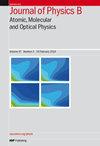Evolution of level population in Ar interacting with XFEL pulses: impact of resonant absorptions
IF 1.5
4区 物理与天体物理
Q3 OPTICS
Journal of Physics B: Atomic, Molecular and Optical Physics
Pub Date : 2024-07-10
DOI:10.1088/1361-6455/ad5ee5
引用次数: 0
Abstract
Theoretical exploration of the population dynamics at fine-structure levels of Ar atoms interacting with ultrafast ultraintense x-ray free electron laser (XFEL) pulses is conducted. A time-dependent rate equation based on a detailed-level accounting approach is applied for tracking population levels, encompassing microscopic atomic processes such as photoexcitation, radiative decay, photoionization and Auger decay. A Monte Carlo algorithm is implemented to solve large-scale rate equations efficiently. The primary investigation centers on generating Ar17+ through resonant absorption by the second-harmonic radiation of the x-ray pulse. The calculated population ratios of Ar17+ to Ar16+ align well with the experimental measurements (LaForge et al 2021 Phys. Rev. Lett.127 213202). In comparison to the transition energy of the strongest line, of Ar16+, there is a distinct ∼25 eV red shift in the peak ratio, which is attributed to the presence of intricate resonant channels in the lower ionization stages. The results demonstrate the sensitivity of the population ratio Ar17+/Ar16+ to the laser pulse parameters such as x-ray pulse duration, bandwidth and the contribution of second-harmonic radiation, indicating their potential as diagnostic tools in future experiments.与 XFEL 脉冲相互作用的氩气中电平群的演变:共振吸收的影响
对与超快超约束 X 射线自由电子激光(XFEL)脉冲相互作用的氩原子精细结构水平的种群动态进行了理论探索。基于细节级核算方法的随时间变化的速率方程被用于跟踪种群水平,包括光激发、辐射衰变、光离子化和奥格衰变等微观原子过程。采用蒙特卡洛算法有效求解大规模速率方程。主要研究集中在通过 X 射线脉冲二次谐波辐射的共振吸收产生 Ar17+。计算得出的 Ar17+ 与 Ar16+ 的种群比与实验测量结果(LaForge 等人,2021 年,Phys. Rev. Lett.127 213202)非常吻合。与 Ar16+ 的最强线的过渡能量相比,峰值比有明显的 ∼25 eV 红移,这归因于在较低的电离阶段存在错综复杂的共振通道。结果表明了 Ar17+/Ar16+ 的种群比对激光脉冲参数(如 X 射线脉冲持续时间、带宽和二次谐波辐射的贡献)的敏感性,表明它们在未来实验中作为诊断工具的潜力。
本文章由计算机程序翻译,如有差异,请以英文原文为准。
求助全文
约1分钟内获得全文
求助全文
来源期刊
CiteScore
3.60
自引率
6.20%
发文量
182
审稿时长
2.8 months
期刊介绍:
Published twice-monthly (24 issues per year), Journal of Physics B: Atomic, Molecular and Optical Physics covers the study of atoms, ions, molecules and clusters, and their structure and interactions with particles, photons or fields. The journal also publishes articles dealing with those aspects of spectroscopy, quantum optics and non-linear optics, laser physics, astrophysics, plasma physics, chemical physics, optical cooling and trapping and other investigations where the objects of study are the elementary atomic, ionic or molecular properties of processes.

 求助内容:
求助内容: 应助结果提醒方式:
应助结果提醒方式:


